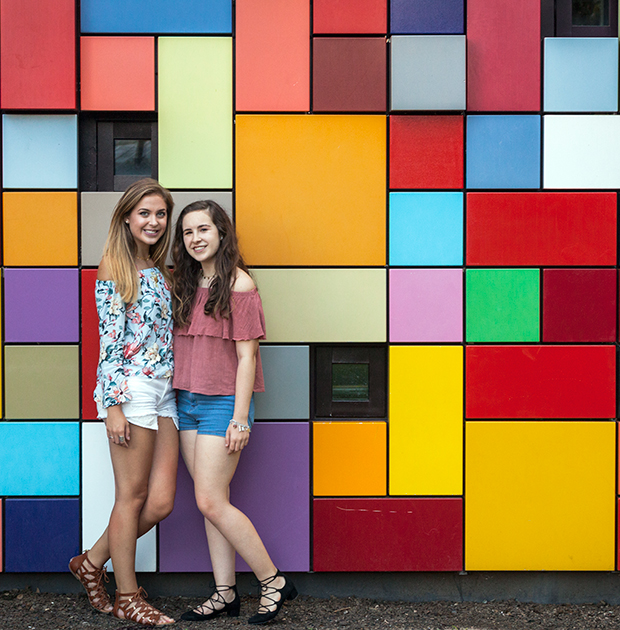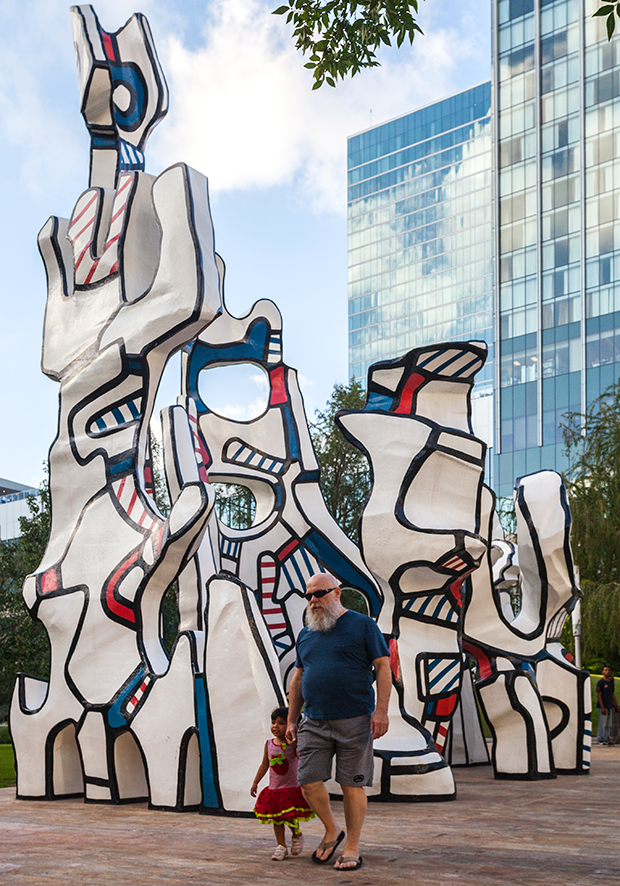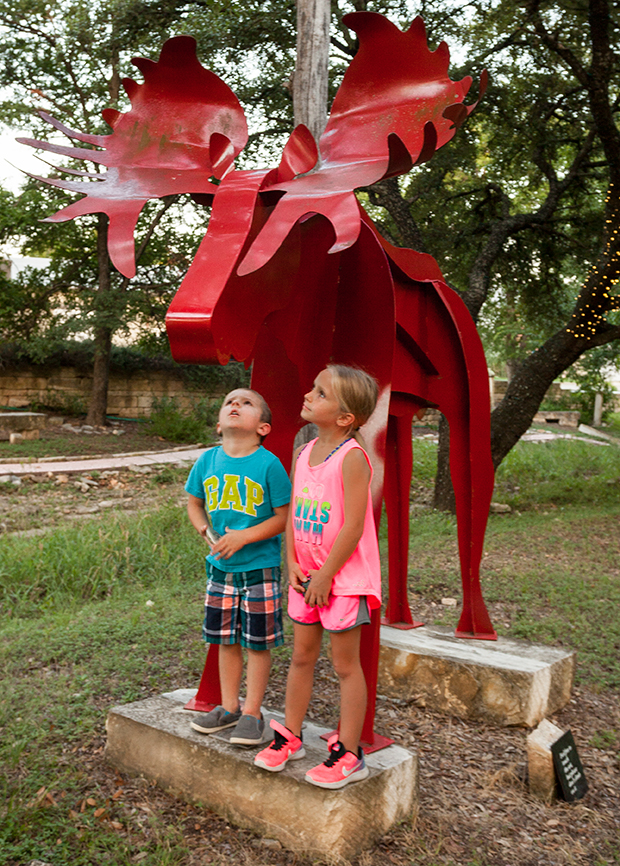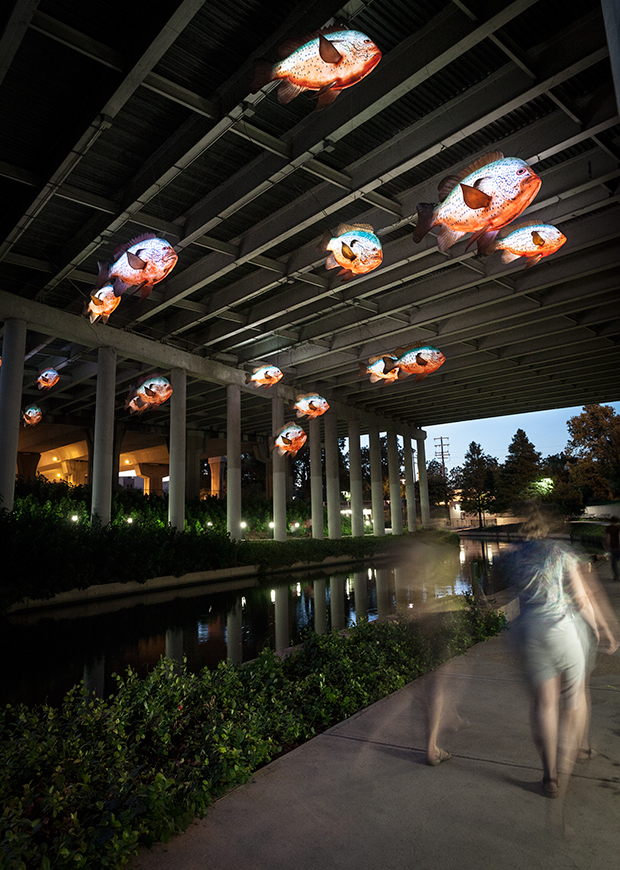
Synchronicity of Color by Margo Sawyer, Houston.
Across Texas, eye-catching public art can be found standing along city freeways and waterways, clustered in town parks, and tucked within college campuses. Whereas some places celebrate the work of a single artist, others highlight a variety of talent, ranging from local artists to those of international acclaim. These sculptures represent recent commissions as well as established landmarks, and they vary from the traditional to the contemporary, with something for just about every taste. Best of all, they are free to see. Here are a few dozen worth exploring around the state.
El Paso
Thanks to the city of El Paso’s active Public Art Program, this West Texas metropolis features multiple artworks along its busy thoroughfares. Several of these roadside attractions were inspired by the surrounding landscape. A 45-foot-tall, blue-gray steel abstraction called Aguacero (2011), by the internationally acclaimed Mexican sculptor Sebastián, represents the occasional downpours of the desert climate. The Cloud (2016), installed in a traffic circle on the west side of town, is one of several Texas commissions by the New York artist Donald Lipski. At first glance, this three-sided structure could be mistaken for a water tower. However, closer inspection reveals that the “tower” is made of hinged steel panels arranged in a cloud shape. These panels flutter in the breeze and mirror passing clouds. Wind also plays a role in Vicki Scuri’s Airway Gateway (2014), located along Airway Boulevard. Its 16 tall metal pillars double as wind turbines, and its related 29 ground-level sculptures mimic desert flora. At dusk, colorful lights illuminate their surfaces. Likewise, Howard Kalish’s Ocotillo (2011) enlivens a roundabout on the east side. This steel sculpture, which resembles its namesake plant, lights up at night with luminous red blooms.
Fort Worth
Since 2001, Fort Worth has been enhancing its urban environment with public art. Wind Roundabout (2015), a three-story-tall kinetic sculpture by Ned Kahn, is part of the ambitious new development plan at Panther Island just north of downtown. Kahn, known for his interactive exhibits at San Francisco’s Exploratorium, sheathed this elevated cylindrical structure with thousands of aluminum flaps that glint in the light and shimmer in the wind. Art has also played a role in the revitalization of downtown neighborhoods, as seen on a half-mile stretch of Lancaster Avenue, where you can find Avenue of Light (2009). California-based Cliff Garten designed the installation’s six sculptural towers, each composed of stainless-steel tiers stacked more than 30 feet high and embellished with laser-cut art deco motifs inspired by the surrounding architecture. At night, these towers become beacons of unusual beauty as light dances over their irregular surfaces. Duck into the nearby Fort Worth Convention Center to check out Donald Lipski’s Intimate Apparel & Pearl Earrings (2005) in the lobby. This massive, three-dimensional star, suspended in midair, is composed of about 400 donated cowboy hats (and two sombreros)—a lighthearted nod to the city’s Western heritage and pioneering spirit. For locations, see fwpublicart.org.
Frisco
The community of Frisco, just north of Dallas, is home to the Texas Sculpture Garden—the largest private collection of contemporary Texas sculpture on public display. Acquired by developer Craig Hall, works by about 40 different artists are scattered across four scenic acres at HALL Park (and about 100 additional works can be found within the office park’s various buildings). Among the homegrown talent is Jerry Daniel of Sanger, whose three-story-tall Dancers MM (2000) greets visitors at the entry to the office park. The simplified lines of this graceful duo, made of concrete over steel, convey a sense of carefree movement. Eliseo S. Garcia of Farmers Branch offers a different kind of duo: His modernist Maternal Caress (2000), carved from a block of limestone, portrays a mother tenderly embracing her child. Several Houston artists are represented, including Edward Lee Hendricks, Paul Kittelson, and Michelle O’Michael. Hendricks’ tall twin spindles (2004 IX and 2004 X) terminate in curving yellow rods that churn in the wind. Kittelson’s oversized Staples (2001) looks as if a giant has misplaced his stapler refills. And O’Michael’s 26-foot-long La Mujer Roja (2000) evokes a reclining female form through looping strips of welded steel, painted a brilliant red. The Texas Sculpture Garden is at 6801 Gaylord Parkway.
Galveston
After Hurricane Ike battered hundreds of trees on Galveston Island in 2008, the Galveston Island Tree Conservancy embarked on a plan to give the dead trees new life as sculptures. Today, Galveston boasts more than 20 of these artful reincarnations. Local homeowners commissioned many of the tree sculptures, most of which are found in the island’s East End Historical District. Chainsaw artist Dayle Lewis of Indiana, who specializes in wildlife forms, carved the elegant Two Crested Herons from a single trunk, and the diverging branches of his Birds of Galveston morph into a flock of 18 birds, including a heron, pelican, ibis, and spoonbill. Several other works honor the island itself. Galveston’s own Earl Jones created Tall Ship ELISSA Figurehead, modeled after the figurehead on the bow of this historic ship, and Island Totem Pole, by Houston artist Jim Phillips, includes an assortment of regional fish and fowl. Among the more imaginative pieces is Jones’ Grandmother Reading to Her Grandchildren, in which storybook characters appear as if springing from the minds of the listening children. Another fictional character, Tin Man from The Wizard of Oz, by Jim Phillips, stands before the former home of King Vidor, who survived the 1900 hurricane and later directed part of that film. For locations, see galveston.com/treesculpturetour.

Monument au fantóme by Jean Dubuffet.

Monument au fantóme by Jean Dubuffet.
Houston
Houston is a gold mine for public art, and two recent additions can be found in the Avenida Houston district, anchored by Discovery Green and the newly refurbished George R. Brown Convention Center. Wings over Water (2016), a 30-foot-tall kinetic sculpture by the Tucson design firm Joe O’Connell and Creative Machines, beckons from outside the center’s entryway. Winglike metal blades undulate above a rectangular basin with spurting fountains, transformed at night by colored lights. Within the center’s atrium, Soaring in the Clouds (2016), by local artist Ed Wilson, also references flight. This multitiered installation features metal mesh formed into flying birds and floating clouds. These elements are animated by the circulating air, and in the evening they take on a whole new aspect as projected light bathes them in pastel hues. Directly across the street at Discovery Green, Synchronicity of Color (2008), by Austin sculptor Margo Sawyer, resembles giant rectangular Rubik’s Cubes composed of irregular metal blocks in an array of vivid shades. Nearby sits one of Houston’s beloved landmarks: Monument au fantôme (1983)—a towering three-dimensional doodle in fiberglass (painted red, white, and blue) by the famous French artist Jean Dubuffet, who was inspired by the imaginative drawings of children. Avenida Houston is at 1001 Avenida de las Americas.
Lampasas
Lampasas has long been known for its mineral springs, but since 2005 this small Central Texas municipality has evolved into an unexpected oasis of public art. The Hanna Springs Sculpture Garden, overseen by the Lampasas Association for the Arts, opened in 2005 with three commissioned sculptures produced on-site, including one by Carolann Haggard, a native Texan now residing in Tennessee. Her Lampasas Furniture (a sofa and chair roughly carved in limestone) invites visitors to kick back and enjoy the scenery. New permanent fixtures are added each year, now totaling 16. Among them, Been Fish’en (2010), by Joe Barrington of Throckmorton, is a fish tale come to life, depicting a pickup truck hauling a monstrously huge yellow catfish. Four brightly painted cartoonish birds make up the playful Bird Totem (2011) by Austin artist Terrell Powell. Nic Noblique of Clyde used weathered steel for his dynamic abstract sculpture We Will Spread, We Will Cover the Earth . . . Like Air and Water, which he donated to the site in 2014. The garden also displays five or six works on a rotating basis, unveiled the second weekend in October during the annual Art in the Park event. Hanna Springs Sculpture Garden is at 501 E. North Ave.

Marvin the Moose by Johnny Shipman, Salado.

Marvin the Moose by Johnny Shipman, Salado.
Liberty Hill
In 1976, a score of artists descended upon the rural community of Liberty Hill, about a 40-minute drive north of Austin, to participate in an international sculpture symposium organized by local artist Mel Fowler. Sculptors from six different countries joined their American peers for the symposium, and each created a work for what would become known as the Liberty Hill International Sculpture Park. Today, this assorted gathering of 28 sculptures stands as a testament to the town’s hospitality. The Japanese artist Mihama Yoshinao left behind a spiraling limestone sculpture called Lotus, a common Eastern motif symbolizing purity. Several other participating artists used limestone to produce various abstract shapes suggesting shells or bones, such as Sans Titre by Jean Louis Marmorat of France and Evolution No. 2 by Renata Reck of Germany. Faces of the People, by Italian artist Renato Mari, comprises four limestone orbs with oversized holes for eyes. Fowler initially contributed four works to the garden. One, Misterio di Vita, meaning “mystery of life,” resembles a mass of spiraling forms melding together, with the dark veins of the Italian marble emphasizing the sense of movement. Liberty Hill International Sculpture Park is at 355 Loop 332.
Lubbock
On the high plains of the Panhandle in Lubbock, the Texas Tech University campus is peppered with public artworks, and you don’t have to be a student to view them. Among the more than 100 works on display outdoors, several relate to their specific locations. For instance, The Messengers (2013) appears outside the Media and Communications Building. Created by Dallas artist David B. Hickman, it features a flock of five messenger pigeons whose metal bodies spin in the wind like weathervanes. The 12-foot-diameter Astrolabe (2014), inspired by an instrument used for measuring the heavens, sits in the Courtyard of the Experimental Sciences Building. The artist, Owen Morrel of New York, added a greenish patina and mirrored surfaces to its intersecting circular steel forms. Outside the College of Architecture is an untitled sculpture from 1974 by former faculty member Robert Bruno that became the model for his Steel House, the idiosyncratic weathered-steel structure at Ransom Canyon, just east of town. And before the University Library stands the Greek literary figure Prometheus (1967–68), by the celebrated Texas sculptor Charles Umlauf. The elongated muscular figure bears aloft a torch—a symbol of his gift of fire to mankind and the power of knowledge. Texas Tech University is at 2500 Broadway. See texastech.ecdu/publicart.
Salado
The Central Texas town of Salado has a population of only about 2,000, but it has big aspirations when it comes to public art. The Salado Sculpture Garden, established in 2011 by the Public Arts League of Salado and Keep Salado Beautiful, occupies more than two acres. This outdoor venue highlights the work of Texas artists, including talented locals such as Troy Kelley and Johnny Shipman. Kelley’s life-size figurative bronze sculpture Late Again (2011) depicts a young boy playing with his dog. Shipman’s Marvin the Moose (2013), of welded steel painted bright red, appears right at home in the natural setting, as does Joe Barrington’s oversized Raven (2015), whose black feathers are made of tire-tread fragments. Winding trails lead to other discoveries. Starburst (2011), a kinetic metal sculpture by Jim LaPaso of Kyle, takes the form of an elaborate silver pinwheel with spiraling arms that catch the wind. About 25 of these works are permanent; others rotate through on an annual basis, so there is always something new to see. This year’s exhibition will debut at the annual Art on Parade event, slated for Sept. 22-23. Salado Sculpture Garden is at 113 Salado Plaza Drive.
San Antonio
There is even more to see on the River Walk since its expansion in 2009. The 1.33-mile urban section of its Museum Reach extension, which offers river access to the San Antonio Museum of Art, extends art-viewing opportunities even beyond museum walls. Privately funded through the San Antonio River Foundation, several commissioned installations punctuate this stretch of river. For Under the Over Bridge, San Antonio artist Mark Schlesinger painted the underside of the Ninth Street Bridge with vibrant stripes using a special paint that glows at night, and he installed four block-like benches with built-in fiber optics—squiggles of light zip across their surfaces and respond to touch. Stuart Allen, also of San Antonio, transformed the McCullough Street and Brooklyn Street underpasses with his 29° 25’ 57” N and 98° 29’ 13” W, in which suspended rectangular panels appear to gradually change color as people pass by. Other works were inspired by the river setting. For F.I.S.H., Donald Lipski hung a luminous school of larger-than-life long-eared sunfish from the I-35 overpass; and local faux bois artist Carlos Cortés used concrete to shape his enchanting Grotto along the riverbank, complete with stalactites and cascading streams.
The urban stretch of the Museum Reach runs from Lexington Avenue to Josephine Street.









